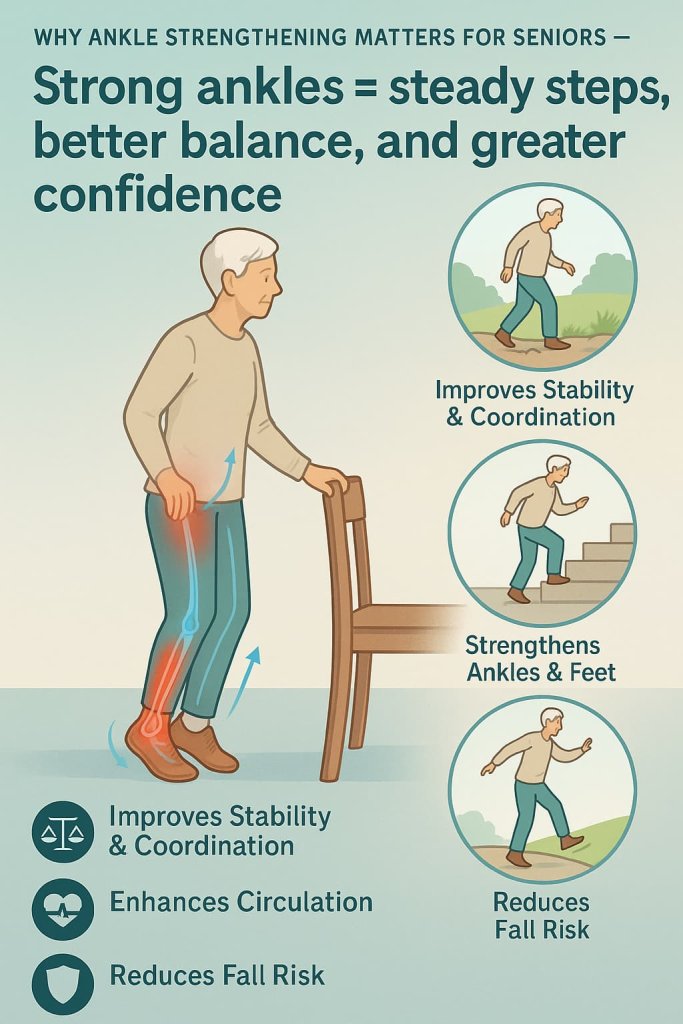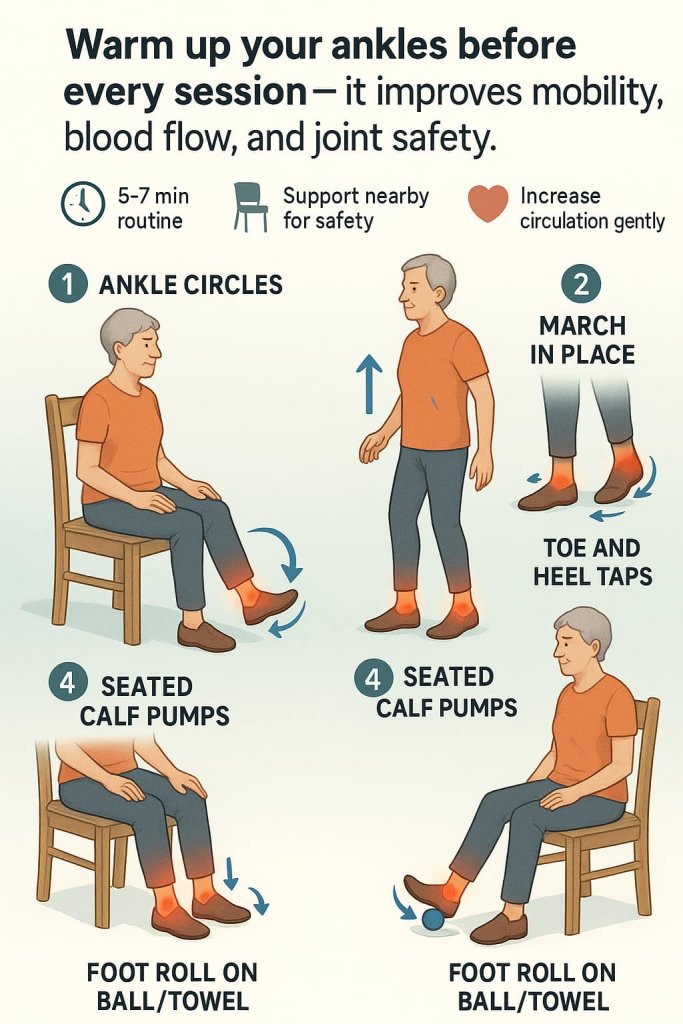Strong ankles are the foundation of stability — and they can be trained at any age. Regular ankle strengthening exercises help seniors improve balance, mobility, and confidence while reducing the risk of falls — one of the leading causes of injury in adults over 65 (CDC, 2024). By practicing these simple, joint-friendly movements a few times per week, you can protect your ankles, walk more steadily, and stay active longer.
Why Ankle Strengthening Matters for Seniors
Ankle and foot muscles play a vital role in balance, walking, and preventing slips. Weak ankles can make daily movements — such as climbing stairs, standing from a chair, or walking on uneven ground — more difficult and unstable.

According to the Centers for Disease Control and Prevention (CDC, 2024), one in four older adults experiences a fall each year, and ankle instability is a key contributor. Research in BMC Geriatrics (2025) confirms that targeted ankle and foot training improves balance, gait control, and lower-limb strength — all crucial for fall prevention.
Key Benefits:
- Improves stability and coordination
- Strengthens lower leg and foot muscles
- Enhances joint flexibility and circulation
- Supports posture and walking performance
- Reduces fall and injury risk
Warm-Up Before You Begin
Spend 5–7 minutes preparing your ankles and legs for movement.

Quick Warm-Up Routine:
- Ankle circles – 10 each direction per foot
- March in place – 1 minute
- Toe taps and heel taps – 10 each
- Seated calf pumps – 10 slow reps
- Gentle foot rolls on a small towel or ball – 30 seconds each foot
Safety Tips:
- Always exercise near a wall, chair, or countertop for support.
- Wear comfortable shoes or go barefoot on a stable surface.
- Move slowly and breathe steadily — never rush or hold your breath.
- If you have balance or joint issues, consult your doctor or physiotherapist before starting.
10 Best Ankle Strengthening Exercises for Seniors
These simple yet effective ankle exercises are designed to improve strength, balance, and mobility safely — no gym required.
Do them regularly to build stability, prevent falls, and stay confident on your feet at any age.
1) Seated Heel Raises
Why it works:
This exercise targets the gastrocnemius and soleus — the main calf muscles that lift your heels during walking and climbing stairs. Strong calves improve ankle stability and help propel your steps, reducing fall risk.
Muscles worked:
Gastrocnemius, soleus, Achilles tendon, ankle stabilizers.
How to do it:
- Sit tall in a sturdy chair, feet hip-width and flat on the floor.
- Press through the balls of your feet to lift your heels slowly.
- Hold for 2–3 seconds at the top.
- Lower your heels back down with control.
- Perform 10–15 reps × 2–3 sets.
Trainer Tip:
To increase difficulty, rest a light weight (like a small dumbbell or water bottle) across your knees for added resistance.
2) Toe Raises (Seated or Standing)
Why it works:
Strengthens the tibialis anterior, the muscle responsible for lifting your toes during walking — crucial for avoiding trips and improving foot clearance.
Muscles worked:
Tibialis anterior, ankle flexors, stabilizers.
How to do it:
- Stand or sit with feet flat and hip-width apart.
- Keep your heels on the floor and lift your toes upward toward your shins.
- Pause at the top, then slowly lower back down.
- Repeat 10–15 reps × 2–3 sets.
Trainer Tip:
If standing, hold a countertop or chair for support to ensure balance and safety.
3) Resistance Band Dorsiflexion
Why it works:
This band exercise strengthens the muscles that lift your foot upward, helping prevent stumbling and improving ankle control during gait.
Muscles worked:
Tibialis anterior, peroneals, stabilizing muscles around the ankle joint.
How to do it:
- Sit on the floor or a firm bed with one leg extended.
- Loop a resistance band around the top of your foot and hold both ends.
- Pull your toes back toward you, flexing your ankle.
- Slowly return to start.
- Do 10–12 reps × 2–3 sets per foot.
Trainer Tip:
Keep the movement smooth — avoid snapping or jerking the band to protect your joint.
4) Resistance Band Plantar Flexion
Why it works:
Strengthens the calf muscles and foot arch, crucial for pushing off when walking or standing on tiptoes.
Muscles worked:
Gastrocnemius, soleus, intrinsic foot muscles.
How to do it:
- Sit tall with the band looped around the ball of your foot.
- Push your toes away from you, stretching the band.
- Hold briefly, then return with control.
- Perform 10–15 reps × 2–3 sets per leg.
Trainer Tip:
Ensure steady resistance throughout — avoid letting the band snap back quickly.
5) Ankle Alphabet
Why it works:
Improves ankle mobility, coordination, and proprioception — key for joint health and fall prevention.
Muscles worked:
Ankle stabilizers, dorsiflexors, plantar flexors, invertors, and evertors.
How to do it:
- Sit comfortably with one leg extended and foot lifted.
- “Write” the alphabet in the air with your toes, moving through all letters.
- Keep the motion slow and controlled.
- Repeat with the other leg.
Trainer Tip:
Draw large, smooth letters to improve control and range of motion.
6) Seated Towel Scrunches
Why it works:
Targets small, intrinsic foot muscles that support arch strength and stability, enhancing balance and reducing foot fatigue.
Muscles worked:
Flexor digitorum, plantar muscles, intrinsic foot stabilizers.
How to do it:
- Sit in a sturdy chair with a towel laid under your feet.
- Curl your toes to pull the towel toward you.
- Release and repeat.
- Perform 10 reps × 2–3 sets.
Trainer Tip:
Add a light object (like a small ball or bottle) on the towel for extra resistance.
7) Standing Heel Raises
Why it works:
Strengthens calves and Achilles tendons while improving ankle stability and foot power for walking and stair climbing.
Muscles worked:
Calves (gastrocnemius and soleus), Achilles tendon, plantar flexors.
How to do it:
- Stand behind a sturdy chair, holding lightly for support.
- Raise your heels off the floor, coming onto your toes.
- Hold for 2 seconds, then lower slowly.
- Do 10–15 reps × 3 sets.
Trainer Tip:
When comfortable, try single-leg heel raises for greater challenge — but maintain safety support.
8) Side-to-Side Weight Shifts
Why it works:
Trains the ankle’s lateral stabilizers to manage side-to-side balance — a key fall-prevention skill.
Muscles worked:
Peroneals, tibialis posterior, hip stabilizers.
How to do it:
- Stand tall with feet hip-width apart.
- Place hands lightly on a chair or wall.
- Shift weight slowly to your right foot, then to your left.
- Keep movements small and controlled.
- Continue for 30–60 seconds × 3 rounds.
Trainer Tip:
Keep both feet grounded and focus on even, slow transitions for better balance awareness.
9) Tandem Stance
Why it works:
Improves balance by engaging your body’s “ankle strategy” — subtle corrections made by the ankle muscles to maintain stability.
Muscles worked:
Calves, intrinsic foot muscles, ankle stabilizers, and core.
How to do it:
- Stand with one foot directly in front of the other (heel touching toe).
- Keep posture upright and look straight ahead.
- Hold for 20–30 seconds, switch legs.
- Repeat 2–3 rounds.
Trainer Tip:
Keep one hand near a wall or chair until confident with balance.
10) Single-Leg Stand (Supported)
Why it works:
Builds proprioception and single-leg balance, directly improving walking stability and ankle control.
Muscles worked:
Ankle stabilizers, glutes, quadriceps, core.
How to do it:
- Stand behind a chair or near a wall for safety.
- Lift one foot slightly off the ground.
- Keep your hips level and maintain posture.
- Hold for 20–30 seconds, then switch legs.
- Perform 2–3 sets per side.
Trainer Tip:
As you progress, reduce hand support gradually — even fingertip balance builds confidence and control.
Programming Tips for Seniors
| Goal | Frequency | Sets & Reps | Rest | Progression |
|---|---|---|---|---|
| Strength & stability | 2–4 times/week | 2–3 sets of 10–15 reps | 30–60 sec | Add resistance, reduce support, increase hold time |
Safety First: If you experience dizziness, pain, or numbness, stop and rest. Always consult your doctor before adding new resistance exercises, especially if you have neuropathy, arthritis, or circulation issues.
FAQs
1. How often should seniors do ankle exercises?
2–4 times per week, with rest days in between for recovery.
2. Can I do these exercises if I have arthritis?
Yes — choose seated or band-based versions and move gently within a pain-free range.
3. How long until I notice improvement?
Most people feel stronger and more stable within 4–6 weeks of consistent practice.
4. Do I need equipment?
No — most of these can be done with just a chair and resistance band.
5. Are these exercises safe if I have balance issues?
Yes, as long as you perform them near support (chair, wall, or countertop).
6. Can ankle exercises really prevent falls?
Yes. Studies show that regular lower-limb and balance training significantly reduce fall risk in older adults.
7. Should I do them before or after walking?
Either is fine — warm up lightly first and stretch gently afterward.
Conclusion
Strong ankles mean stronger balance, better mobility, and more independence. These 10 ankle strengthening exercises for seniors are simple, safe, and proven to work — helping you walk confidently and prevent falls.
Start today: Practice 2–4 times per week, progress gradually, and celebrate your improved stability and freedom of movement.
Disclaimer: This content is for informational purposes only and is not medical advice. Always consult your healthcare provider before starting a new exercise program.
References
- CDC — Facts About Falls (2024) — 1 in 4 adults 65+ falls each year; falling once doubles the risk of falling again.
https://www.cdc.gov/falls/data-research/facts-stats/index.html - CDC — Physical Activity Basics: Older Adults (2023) — Recommends 150 min/week aerobic + muscle-strengthening 2+ days/week and balance activities.
https://www.cdc.gov/physical-activity-basics/guidelines/older-adults.html - Cochrane Review (2019): Exercise for Preventing Falls in Older People Living in the Community — Programs emphasizing balance/functional training reduce falls.
https://www.cochrane.org/evidence/CD012424_exercise-preventing-falls-older-people-living-community - PLOS ONE (2025) — Dorsiflexion Force Control & Falls Risk — Age-related deficits in ankle dorsiflexion force control relate to balance/gait problems in older adults.
https://journals.plos.org/plosone/article?id=10.1371/journal.pone.0319578 - Standing Balance Training → Gait Stability (2022, Open-access) — Ten sessions of standing balance training improved gait stability and neuromuscular control in older adults.
https://pmc.ncbi.nlm.nih.gov/articles/PMC9328559/
